.568.jpg)
The Nigerian Montane Forest Project’s field station set in the Ngel Nyaki Forest. Photo by: Pierre-Michel Forget.
Between 2000 and 2010, Nigeria lost nearly a third (31 percent) of its forest cover, while its primary forests suffered even worse: in just five years (2000 to 2005) over half of the nation’s primary forests were destroyed, the highest rate in the world during that time. Yet, Nigeria’s dwindling forests have never received the same attention as many other country’s, such as Indonesia, Brazil, Malaysia, or Peru, even though in many ways Nigeria struggles with even deeper problems than other developing nations. Despite vast oil business, the nation is plagued by poverty and destitution, a prime example of what economists call the ‘resource curse’. Environmentally, it has been named one of the worst in the world. Yet, not all forest news out of Nigeria is bleak: the success of the Nigerian Montane Forest Project in one of the country’s remaining forests is one such beacon of hope, and one example of how the country could move forward.
Founded by Nigerian native and evolutionary ecology professor with the University of Canterbury, New Zealand, Hazel Chapman, the Nigerian Montane Forest Project seeks to combine scientific studies, education, and community management in the threatened Ngel Nyaki Forest, a small forest—720 hectares—that is home to the world’s most imperiled population of chimpanzees: the Nigeria-Cameroon chimpanzee (Pan troglodytes ellioti) subspecies. Growing up in Malawi and Nigeria with a father who was passionate about botany, and who would take his intrepid daughter with him on forest expeditions, convinced Hazel Chapman to pursue a career in ecology. She traveled the world, studying in Scotland and New Zealand, but in 2002 Chapman returned to Nigeria to explore some of the remaining montane forest in Nigeria.
“The aim of the expedition was to revisit the forests my father had worked in during the 1970s and see how they had fared over the years. Our survey involved 50 days of trekking, mainly in the Gotel Mountains and Mambilla Plateau, with a base in Gashaka Gumti National Park. One of the forests we visited on the Mambilla Plateau was Ngel Nyaki Forest, and I couldn’t help thinking that it would be a perfect site for field research.”
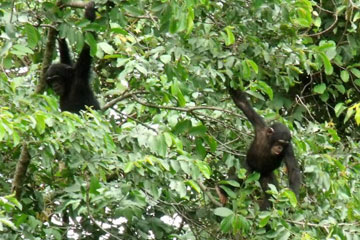 Nigeria-Cameroon chimps in the Ngel Nyaki Forest. Photo courtesy of: Paul Dutton. |
In 2004 Chapman returned with students to undertake the first studies in the Ngel Nyaki Forest. By the next year, building began on the field station. Today the project is booming.
“We now employ 22 people full time, have a research block, an accommodation block with 10 bed rooms, and satellite internet. Internet access has made a huge difference. It means that students can be supervised remotely, and also means that I can help in the administration at a moments notice,” Chapman told mongabay.com in an interview. “Last year we created an Advisory Board, including three young lecturing staff from Gombe State University. All three are doing research projects based at Ngel Nyaki and two are enrolled at University of Canterbury for their PhD. I see these guys as the future of the Project.”
The project has led to unique research on montane forests in the country, which, although near-vanishing, are important refuges for Nigerian biodiversity.
“What makes Nigerian montane forests so interesting in terms of biodiversity is that, as part of the Cameroon Volcanic Line, they are a hotspot of biodiversity. Many taxa are endemic to this chain of mountains, or even to particular mountains,” says Chapman
In addition to a small population of Nigeria-Cameroon chimps, Ngel Nyaki houses a number of other notable primate species and has been declared an Important Bird Area (IBA) for rare and endemic species. In addition, new species have recently been described from the area.
The Nigerian Montane Forest Project has helped save these species, and the forest they inhabit, from neglect, a neglect that could have eventually resulted in complete collapse of the ecosystem.
“Ngel Nyaki is a designated Forest Reserve, so that officially there is no reason that it should not be protected. However between the early 1980s and the beginning of the Project the reserve was ignored by the authorities. No salaries were paid and hunting/grazing became commonplace,” Chapman explains, adding that “the main threats to the forest flora are grazing from cattle, burning, and selective logging of trees for fence posts and firewood. The Fulani pastoralists graze both on Mambilla Plateau and within Plateau enclaves in Gashaka Gumti National Park. This is most extreme in the case of Ngel Nyaki forest, but everywhere the riparian forest is being degraded and often on Mambilla Plateau, totally destroyed and replaced by crops. In addition hunting is rife and, as everywhere, the forests are losing their large frugivores [fruit-eaters]. The number of small frugivores is declining too. While in the 1970s these areas were so remote as to be relatively safe from hunting, increased human population pressure and more road infrastructure means this is no longer the case.”
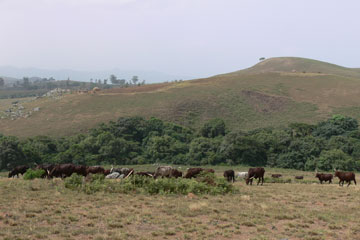 Cattle grazing by riverine forest fragment. Photo courtesy of: Hazel Chapman. |
Despite these on-going threats, at least the success of Nigerian Montane Forest Project has caused the forest to be viewed once again as a vital resource for local communities. The state government is funding 20 full time patrollers to protect the forest from intrusion, and Chapman says researchers and assistants tromping regularly through the environment also helps keep poachers at bay. Local workers have gained the most from the project.
“Misa and many others see the forest as equivalent to their cows, that is, it is their children’s future,” Chapman explains.
Still, Chapman, who has been sponsored by two Rufford Small Grants for Nature Conservation as well as the The Mohamed bin Zayed Species Conservation Fund, warns that the future of the forest—and other protected areas in Nigeria—are in no way assured.
“Unless severe action is taken to remove cattle from within Forest Reserves and Gashaka Gumti National Park the future does not look good. Additionally increased human population pressure is leading to more hunting of animals and plants—the latter includes lichens and bulbs. However if action IS taken, (and we are extremely fortunate in Taraba State with our Governor, Danbaba Suntai, and Commissioner of the Environment, Gebon Tim Kataps Esq. then there is the potential for montane forests to survive in Nigeria. The influence of UN REDD is as yet an unknown, but it is certainly bringing the importance of having forest cover to the attention of authorities,” she says.
In a July 2011 interview Hazel Chapman discusses the history of The Nigerian Montane Forest Project, the fragile ecosystems of montane forests in Nigeria, and the hope of research, education and community programs in a neglected place.
INTERVIEW WITH HAZEL CHAPMAN
Mongabay: What is your background?
Hazel Chapman: I was born in Africa—in Malawi—and we later moved to Nigeria. My father was a forester with a passion for forest botany, and through his work we lived in remote places in each country. I was introduced to montane forests first in Malawi and later in Nigeria. In Nigeria we lived on the Mambilla Plateau, on the Nigerian/Cameroon border. During the holidays I would trek with my father on his botanical expeditions. Not surprisingly, I studied botany and ecology at university: my undergraduate at St Andrews in Scotland, my MSc in ecology at the University of Aberdeen, Scotland and PhD at the University of Otago, New Zealand. I am now a faculty member in the School of Biology at the University of Canterbury, New Zealand. I teach evolutionary ecology and have research interests ranging from the evolution of invasiveness in plants to plant-animal mutualisms in tropical forests.
Mongabay: Why Nigeria?
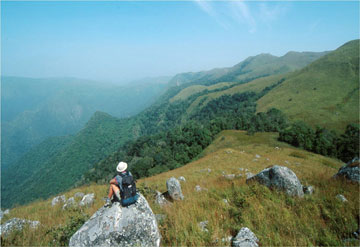 View in the Gotel Mountains. Photo by: Matt Walters. |
Hazel Chapman: As I said, my parents lived in Nigeria during the 1970s and I visited them there during school and later, University holidays. In those days the mountainous Southeast corner of Taraba State where we lived was very remote. The area comprises the Gotel mountains, now within Gashaka Gumti National Park and the Mambilla Plateau. Mambilla is a huge expanse of gently rolling hills. Then, as now, it was covered in overgrazed grassland with forests confined to the escarpment edge and along stream sides criss-crossing the grassland. It is home to Mambilla subsistence farmers and Fulani pastoralists and their cattle.
Nearly 25 years later in 2000 I co-authored a book The Forests of Taraba and Adamawa States, Nigeria with my father. My father had a huge amount of data and photographs from his Nigerian surveys which had been incorporated into reports but never published. After our book was published I became increasing interested in returning to Mambilla and the Gotel Mountains. This became a reality in 2002 when sabbatical leave from the University of Canterbury provided the opportunity I needed to organize an expedition to return. Our expedition comprised five researchers from the University of Canterbury, and a representative from The Nigerian Conservation Foundation. It was assisted by and Nigerian National Parks. The aim of the expedition was to revisit the forests my father had worked in during the 1970s and see how they had fared over the years. Our survey involved 50 days of trekking, mainly in the Gotel Mountains and Mambilla Plateau, with a base in Gashaka Gumti National Park. One of the forests we visited on the Mambilla Plateau was Ngel Nyaki Forest, and I couldn’t help thinking that it would be a perfect site for field research. The forest was only 50 minutes walk from a road, some of the villagers remembered me from the old days and our guides, Misa Zubairu and Augustine Ntim, were extremely enthusiastic about us being there. All the other montane forests we visited were much more remote.
Mongabay: What is the history of the Nigerian Montane Forest Project?
Hazel Chapman: I was able to return to Ngel Nyaki for a very short visit in 2003 and was re-united with Misa and Augustine, who were thrilled to see me. With their support it seemed feasible to begin research the following dry season (November 2004) with postgraduate students from UC. This came to pass and that year four postgraduate students—Ihuma Jerome and Stephen Gawaisa from FUTY (Federal University of Technology, Yola) and Josie Beck and Arne Mattheus from UC and myself started research projects at Ngel Nyaki. We camped on the forest edge and despite difficult logistics the first field season was a success. Our research included an estimate of the chimp populations using nest counts, a test of the Janzen Connell hypothesis, and investigations into seed dispersal.
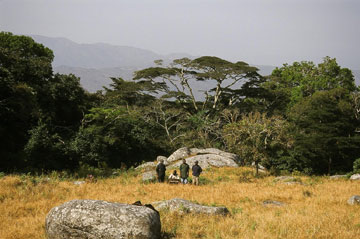 Edge of Ngel Nyaki forest. Photo courtesy of: Hazel Chapman. |
Through Phil Hall, a conservationist based in Lagos, I was also able to spend time doing the rounds of Lagos businesses, touting for funding. This was desperate work, but in the end it paid off—I was sponsored by Nexen Inc., a Canadian oil company with a subsidiary in Nigeria. Nexen saved the day. They guaranteed modest but annual funding and in addition paid for our first building. With additional invaluable support from A. P. Leventis and later the North of England Zoological Society, by January 2005 we were in a position to start building our field station. Taraba State Forestry were fully supportive and allowed us to build within the Reserve Boundary. For me, these few years were a combination of research and establishing the Nigerian Montane Forest Project—the latter was extremely time consuming and frustrating in that I couldn’t concentrate on research as much as I needed to (this had all to be fitted in outside teaching times) but satisfying in that I could see the Project developing. Misa was a huge support always, and it was a combined effort. We now employ 22 people full time, have a research block, an accommodation block with 10 bed rooms, and satellite internet. Internet access has made a huge difference. It means that students can be supervised remotely, and also means that I can help in the administration at a moments notice.
Last year we created an Advisory Board, including three young lecturing staff from Gombe State University. All three are doing research projects based at Ngel Nyaki and two are enrolled at UC for their PhD. I see these guys as the future of the Project. We have obviously developed strong links with Gombe State University and from the beginning had good relations with the Federal University of Technology, Yola. In fact the salary they paid me for supervision was a major contribution towards the projects funding in those first few years.
We are now developing links with the new Taraba State University. As well as postgraduate research, we have held MSc field courses in biodiversity, conservation and taxonomy. The Project also hosts school groups and undergraduate groups who are on field trips from their own University in Nigeria. Significantly we have a very good relationship with the State Governor, Danbaba Suntai. It is thanks to State funding that the Project has grown as it has.
NIGERIA’S MONTANE FORESTS
Mongabay: How much montane forest is left in Nigeria?
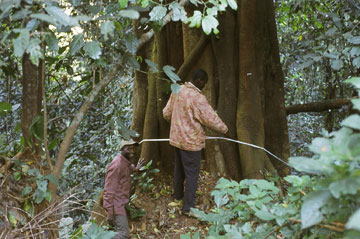 Measuring a large ficus species. Photo courtesy of: Hazel Chapman. |
Hazel Chapman: Not very much—at most, approximately 46km squared, is within Gashaka Gumti National Park in Taraba State. These are amazing forests and line the steep slopes of Gangirwal, Nigeria’s highest mountain at 2400m. Smaller forests include Leinde Fadale and Ngel Nyaki forest. Sadly while Ngel Nyaki Forest Reserve is approximately 40km squared, the area of forest is only 7.2. In addition to the Taraba State forests are patches in Adamawa State (the most northerly and driest) in Nigeria, and small pockets on Obudu Plateau in Cross River State. However while we are unclear as to the history of montane forest in Nigeria, it seems that it has been fragmented for many hundreds of years. Typically the more extensive forest areas are confined to the steep slopes of the escarpment edges and riparian forest lines streams criss-crossing Plateau grasslands. Many of these riparian strips are only a few meters wide.
Mongabay: What is threatening the remaining forests?
Hazel Chapman: The main threats to the forest flora are grazing from cattle, burning, and selective logging of trees for fence posts and firewood. The Fulani pastoralists graze both on Mambilla Plateau and within Plateau enclaves in Gashaka Gumti National Park. This is most extreme in the case of Ngel Nyaki forest, but everywhere the riparian forest is being degraded and often on Mambilla Plateau, totally destroyed and replaced by crops. In addition hunting is rife and, as everywhere, the forests are losing their large frugivores [fruit-eaters]. The number of small frugivores is declining too. While in the 1970s these areas were so remote as to be relatively safe from hunting, increased human population pressure and more road infrastructure means this is no longer the case. Hunters of both animals and plants come from within Nigeria and across the border in Cameroon.
Mongabay: The Nigerian Montane Forest Project works in the Ngel Nyaki forest. What makes the project come together?
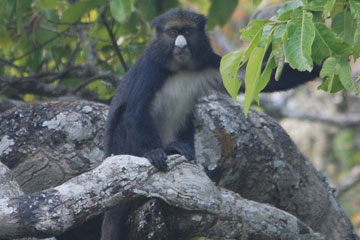 One denizen of Ngel Nyaki forest: the putty nose monkey. Photo by: Matt Walters. . |
Hazel Chapman: The answer as to why the Project works is personal relationships. But also the Project is a major employer in the village and surrounding area. As I said previously, we employ 22 full time staff—mostly field assistants, but also two maigadi (watchmen), a tree climber and a cook. Misa and many others see the forest as equivalent to their cows, that is, it is their children’s future.
Mongabay: What are some of the noteworthy species surviving in the forest?
Hazel Chapman: In Ngel Nyaki the most iconic species is the endangered Nigerian/Cameroon chimpanzee, Pan troglodites ellioti. Using nest counts we have estimated there are only 15 adults in the forest, although there are many more in Gashaka Gumti National Park. In the recent past it is likely there was gene flow between the populations, and between Ngel Nyaki and Cameroon populations. It is hard to imagine such gene flow today—although we can’t rule it out entirely. Other primates in the forest include the black and white colobus (Colobus guereza) and the putty nose monkey (Cercopithecus nictitans). What makes Nigerian montane forests so interesting in terms of biodiversity is that, as part of the Cameroon Volcanic Line, they are a hotspot of biodiversity. Many taxa are endemic to this chain of mountains, or even to particular mountains. A new species of Arthroleptis (a frog) was recently identified by herpatologist David Blackburn, and based on what is known of their taxonomy and biogeography more herps new to science—endemics/near endemics—are likely to be found in the future.
As I said before Ngel Nyaki is an Important Bird Area (IBA) known for its restricted range species such as Bannermans weaver (Ploceus bannermani) and the yellow brested boubou (Laniarius atroflavus). Ngel Nyaki is one of the most floristically diverse montane-submontane forest stands in Nigeria. Several tree species are endemic or (near) endemic to the Afromontane Region, and at least four endangered tree species Entandrophragma angolense, Lovoa trichilioides, Millettia conraui and Pouteria altissima are common. We have discovered a new species of understory tree Memecylon sp. (Melastomataceae) other specimens look promising in this regard. We have very little information on bats and would welcome research in this area.
Mongabay: What is being done to safeguard this particular forest?
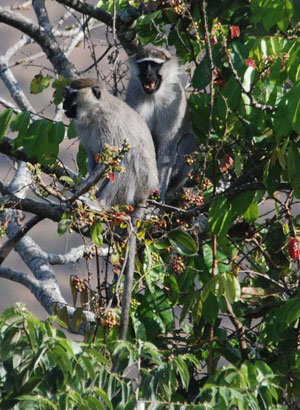 Tantalus monkeys. Photo by: Matt Walters. |
Hazel Chapman: Ngel Nyaki is a designated Forest Reserve, so that officially there is no reason that it should not be protected. However between the early 1980s and the beginning of the Project the reserve was ignored by the authorities. No salaries were paid and hunting/grazing became commonplace. From 2005, thanks to funding from A.P. Leventis, the Project was able to pay token salaries to six patrollers who tried to control hunting. Then, in 2009, the State Governor approved a budget to pay 20 full time patrollers. These funds are administered by the Project and the patrollers are managed by the Taraba State Forest Service. Fencing has been put in place to keep cattle out, although such fences are almost always destroyed by the Fulani. The presence of our researchers and field assistants certainly helps reduce hunting.
Mongabay: The program has started a reforestation project. How is this progressing?
Hazel Chapman: Well, I think, although it is in the early stage. We began by simply fencing off areas of grassland adjacent to the forest and keeping out cattle and burning. At the same time we introduced seed traps into fenced-off areas and have introduced experiments looking at a range of management options such as controlled burning, perches and cutting. We now have seed trap data for five years and clearly seedlings are establishing despite the dense grass mat. Hopefully our work will act as a model for other reserves in Taraba State. I am the Taraba State Representative for UN REDD Nigeria committee, and this kind of restoration work is very much what we are aiming for.
Mongabay: What do you see as the future for Nigeria’s montane forests?
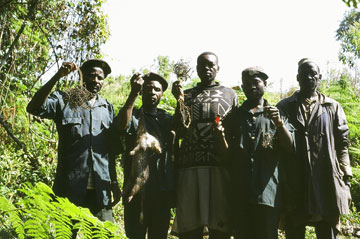 Volunteer patrollers in 2005. Photo courtesy of: Hazel Chapman. |
Hazel Chapman: That is a very difficult question. Unless severe action is taken to remove cattle from within Forest Reserves and Gashaka Gumti National Park the future does not look good. Additionally increased human population pressure is leading to more hunting of animals and plants—the latter includes lichens and bulbs. However if action IS taken, (and we are extremely fortunate in Taraba State with our Governor, Dnabab Suntai, and Commissioner of the Environment, Kataps) then there is the potential for montane forests to survive in Nigeria. The influence of UN REDD is as yet an unknown, but it is certainly bringing the importance of having forest cover to the attention of authorities.
FOREIGN STUDENTS AND LOCAL COMMUNITIES
Mongabay: You have described the Nigerian Montane Forest Project as a ‘case study of global relevance’. What do you mean by this?
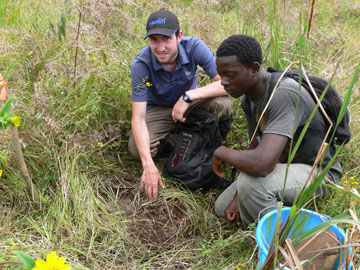 Andrew and Adris researching dung beetles. Photo courtesy of: Hazel Chapman. |
Hazel Chapman: All over the world forests are increasingly fragmented. Restoration programs are underway. New Zealand students and students of other nationalities studying conservation and forest restoration must benefit by exposure to other scenarios.
Mongabay: What are some of the current research being undertaken at the site as we speak? Are these primarily New Zealand students or Nigerian?
Hazel Chapman: There are currently nine PhD/MSc projects based round Ngel Nyaki. Much of this has a focus on plant-animal interactions, and specific projects include: a PhD study of the chimp ecology, with a focus on the role of the chimps in seed dispersal; a PhD study on the affects of fragmentation on tree species composition, testing hypotheses about the interaction of seed size, frugivore availability and disturbance; an MSc on the affects of forest restoration practices on dung beetle species diversity and functional traits; and a PhD testing the hypothesis around habitat affects on avian fitness, using the endemic yellow breasted boubou as a model species. Students are approximately 50:50 New Zealand and Nigerian. Most of the Nigerian students are enrolled at Canterbury University.
We are very fortunate in having international experts help in the way of supervision. For example Janette Wallis (US), Mike Lawes (Australia) and Britta Kunz (Germany) are involved in primate projects, Pierre-Michel Forget (France) in seed dispersal. Several faculty professors from my university in New Zeland also help supervise students.
Mongabay: Will you tell us about the nursery school that the Nigerian Montane Forest Project has played an instrumental role in building for local children?
 Field assistant, Usman, checking seed traps. Photo by: Matt Walters. |
Hazel Chapman: The Waikili of Yelwa (village elder) identified the need for a nursery school. The village, about 40 minutes walk from the field station, had no nursery school, yet at least 300 children of nursery school age. Through a friend in Lagos, Robert Warren, we managed to attract funding from Exxon Mobil to build a school. The Local Government now provide three teachers and officially administer the school. However while it is hugely popular and has done the Project no end of good in terms of relationships with the village, it is desperately in need resources in the way of books and toys.
Mongabay: How is the project contributing to local educational opportunities?
Hazel Chapman: Very much I believe. Several of the field assistants are trained in word processing and data entry. Others have been trained in bird, plant and insect identification. By paying salaries and providing a stimulating environment the project creates opportunities for field assistants to go to school or continue on with education.
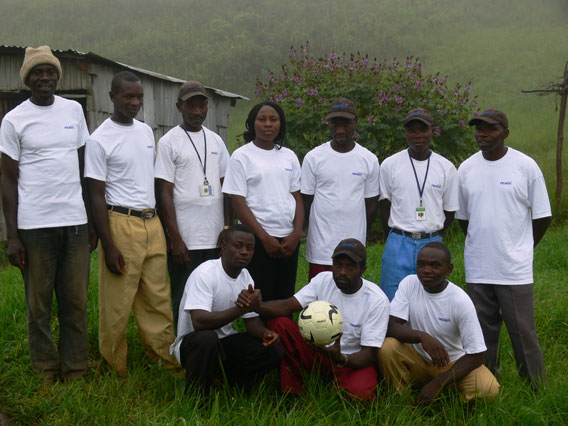
Field assistants and cook. Photo courtesy of Hazel Chapman.
Related articles
Conservationists seek $15M for rarest chimp
(06/27/2011) A new conservation plan calls for $14.6 million to save the world’s rarest subspecies of chimp: the Nigeria-Cameroon chimpanzee, reports the Wildlife Conservation Scoeity (WCS).
How do we save Africa’s forests?

(06/19/2011) Africa’s forests are fast diminishing to the detriment of climate, biodiversity, and millions of people of dependent on forest resources for their well-being. But is the full conservation of Africa’s forests necessary to mitigate global climate change and ensure environmental stability in Africa? A new report by The Forest Philanthropy Action Network (FPAN), a non-profit that provides research-based advice on funding forest conservation, argues that only the full conservation of African forests will successfully protect carbon stocks in Africa.
Nigeria moving forward on REDD to protect last remaining forests
(02/19/2011) The tiny state of Cross River, Nigeria, has managed to preserve large swathes of endangered rainforest despite lucrative – and often intimidating – offers from loggers and other interests. It’s also laid the groundwork for a state-wide program designed to earn international carbon credits by saving trees, thus securing its spot in an elite network of states that are moving forward as UN talks stall.